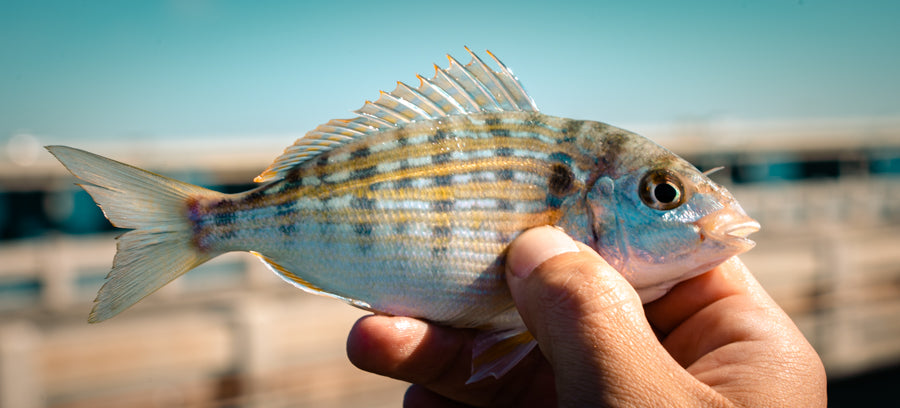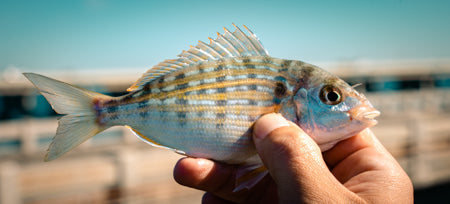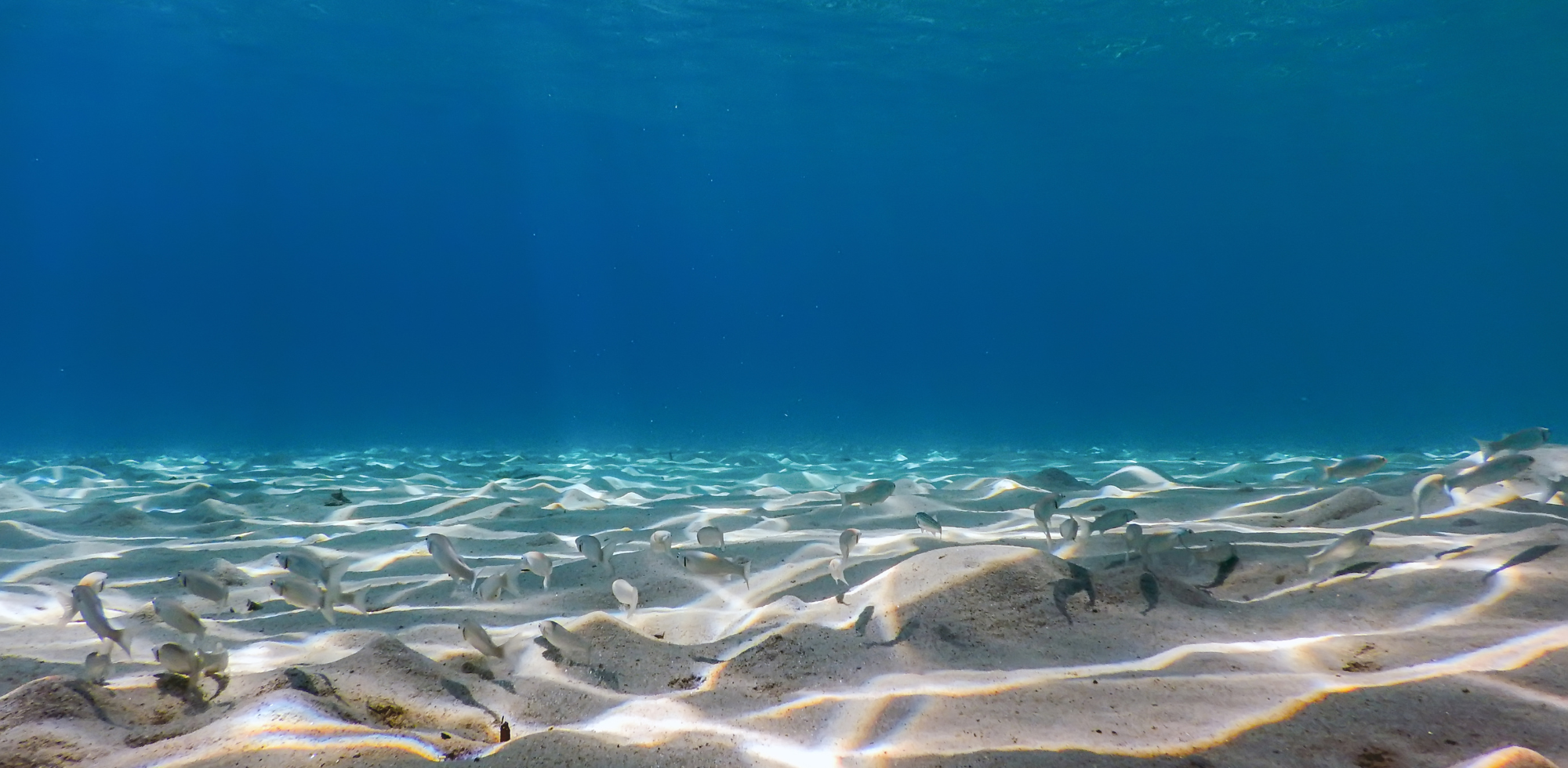Ever wonder why a pinfish is called a pinfish? Well, if you have ever dehooked one or grabbed a fish out of a bucket to use for bait, you probably already know. Pinfish are known for their hypodermic type dorsal fins that seem to prick you regardless of any precaution you take. The dorsal fin contains twelve sharp spines. I often wonder how any larger game fish would or could consume one. I guess that goes to show you how tough the fish's mouths are. In this article, I will cover everything you need to know about pinfish. I will be discussing how to catch pinfish with a castnet, hook and line, traps, and we will even delve into scientific names and more.

Pinfish Identification
Appearance
- Pinfish are quite beautiful and consist of yellow, silver, and blue stripes that run parallel on the body.
- A distinct black dot lays right behind the gill cover and usually aligns with the lateral line.
- Sharp pin-like dorsal and anal fins are very prevalent and will stick you with every opportunity given.
- Pinfish have a mouth full of teeth capable of devouring flesh and small crustaceans.

Size
Pinfish make a great bait because they usually don't exceed seven inches. That and every game fish that swims looks at them like the tasty skittle of the sea.
Pinfish are known to be effective bait thieves; their subtle peck and elusive ways to remove the bait from a hook is genuinely remarkable and frustrating.
Pinfish Range

The beauty of pinfish is that they are abundant and readily available from the Texas coast up to Massachusetts. We have created a unique pinfish map showing their diverse range. Pinfish can tolerate tropical climates and cooler weather; they can thrive in freshwater estuaries for periods.
Environmental Impact
One elegant fact that I was not aware of until recently is the environmental impact that pinfish have on seagrass. It comes to find out that pinfish primarily forage on seagrass. Pinfish eat their shelter, but the grass is ultimately groomed and grows faster and stronger by doing so.
The Easiest Way to Get Pinfish
I hate to state the obvious here, but the easiest way would be to purchase pinfish at your local bait store. Now, I don't recommend this because paying $8 per dozen or more for a readily available baitfish seems counterproductive. That is unless you want to go fishing and not waste time catching your bait. Here are some of the Tampa Bay and central Florida bait shops we recommend:
- Gator Jim's Tackle Address: 3301 Pinellas Point Dr. S, St. Petersburg, FL 33712 | Phone: (727) 363-0900
- Bait and Tackle of Apollo Beach Address: 6040 N U.S. Hwy 41, Apollo Beach, FL 33572 | Phone: (813) 296-7735
- Swany's Bait House Address: 1007 Neptune Dr, Ruskin, FL 33570 Hours: Open 24 hours | Phone: (813) 321-9087
- Wet Lines Bait and Tackle Address: 200 Seminole St, Clearwater, FL 33755 | Phone: (727) 900-2757
Catching Pinfish with a Castnet
A castnet can be a super-efficient method for catching pinfish and baitfish alike. In some instances, one or two pancake throws of the net can fill the well. The key is to chum them up on a healthy grass flat; they respond very well to Tropical Purina fish food mixed with menhaden oil. Please pay close attention to your mixture, and be sure to get the consistency right so that it disperses accordingly throughout the water column. Here is a video I made not that long ago showing the method with greenbacks, AKA pilchards:
The same technique applies when targeting pinfish. The texture that I am referring to is similar to a flour dough ball. You want to roll quarter-sized balls and throw them close to the boat or structure. You also want to be mindful of how you close the net. Allow the castnet to hit the ocean floor and then gradually pop the braille lines closing the net but dragging the seafloor. Doing this will prevent any of the tricky rascals from escaping.
Catching Pinfish with Homemade Sabiki Rigs
The sabiki rig is one of the most effective bait catching rigs that you can use to put baitfish in the boat. You may opt to make your own or purchase a premade sabiki at your local tackle store. I will talk more about the premade rigs in just a moment. Making your sabiki is quite simple; now, I am a visual learner myself, I will be attaching another educational fishing YouTube video for visual aid purposes. I also wrote an entire article on the subject, which you can see here: Homemade sabiki rig. The items needed to complete your rig include:
- Hooks, 3-6 plain for use with bait, or feathered for bare presentation. (make sure to check local regulations for hook limits)
- Line, 5-6 ft
- Swivel, snap
- Swivel, barrel
- Weight, 1-2 ounce depending on water conditions

The idea is to thread all of the hooks on your mainline and then tie dropper loop knots to finish each hook. It sounds much more daunting than it is. Be sure to watch the video, and I think you will agree. Once you have made your rig, I suggest tipping your hooks with fresh squid or, even better, small shrimp pieces. Squid will undoubtedly stay hooked for more extended periods, but I find that I catch dozens more pinfish when using fresh shrimp pieces. I have tested these methods hundreds of times, and shrimp beat out squid 98% of the time.
There is a technique to sabiki fishing for pinfish. If I drop the weight to the bottom and slowly lift the rod tip when I feel the pecks, I seem to hook fish much more effectively. Think of it like the cat and mouse game; when you start to pull the string away from the cat, it pounces or acts more aggressively. The fish do the same thing when they see their food getting away.
Catching Pinfish with Pre Scented Sabiki Rigs
There is a new company that I recently made a video for and found their products to work very well. It's such a simple but intelligent idea. I am surprised no one thought of it sooner. It's a pre scented sabiki that tipped with synthetic artificial pieces of shrimp or squid. Essentially, they are pieces of fabric soaked in baitfish scents. The concept is supposed to allow you not to purchase shrimp or squid and prevent you from getting all fishy with bait hooking and dehooking. While using it, I noticed that I could catch approximately 20 to 25 baitfish before losing all of the synthetic bait strips from my hooks.
Sometimes I prefer using sabikis over the castnet method because it helps the pinfish to stay alive longer. The castnet is much more efficient, but it can do a number to the scales and overall well being of the fish.
Catching Pinfish with Traps
The simplest of all the pinfish methods would have to be the pinfish traps. However, I didn't mention it first because usually, it takes quite a bit more time, and it is best to set the trap and come back a couple of hours later. The concept is very straightforward. You have a mesh trap, as pictured below.

A door allows you to open it and add a bait block that will ultimately attract pinfish and similar baitfish. The fish swim through the trap door, imprisoning them in the cage. It is not uncommon to pull up your trap and have a couple of dozen baitfish. I know many captains who use these regularly and set them the day before their trip. The next morning they visit the trap and up comes a few dozen fresh pinfish with little to no effort. You can invest in a chum block or make your own by grinding up greenbacks and adding menhaden. After you mix the two ingredients, all you have to do is freeze it. You can also use ingredients such as:
- Cat food
- Squid
- Old fish carcasses
If you live on the water, you can quickly deploy a trap right from your dock, and the chances are you will have pinfish in just a few short hours.

Keeping Pinfish in a Bait Pin
I have mentioned it several times already, but pinfish are very durable and can be kept alive in a bait pin for weeks at a time. You can opt to build a bait pin from everyday household items such as PVC, or you can purchase a premade pin at your local tackle store. Heck, you can even get them delivered right to your door from Amazon. The R & R collapsible bait pin works well. It is designed with quality PVC and has coated wire to protect against corrosion. You can store the pin at marinas or your dock for your convenience. It's also made in America.
The key to keeping your pinfish alive is feeding them. I like using Tropical Purina fishing food. Sometimes under duress, the pinfish won't eat, but others will so be sure to keep feeding them.
What Can You Catch with Pinfish?
Now that you know how to catch pinfish, what eats pinfish? As I mentioned earlier, most predatory fish eat pinfish, but a few species can't resist them. They include:
Grouper
One of my go-to baits for both gag and black grouper are pinfish and pigfish. Pinfish are frequently abundant around rock rubble, reefs and wrecks. Have you ever heard the saying "Match the hatch"? Pinfish are hardy baits, and when fresh, they have an extreme burst of energy, which often entices a BIG grouper strike. However, if you notice that your baitfish is a little too fast, you can clip the fins to slow them down a bit. Doing so also may make them look wounded, and sometimes that is enough to get the bite.
Snook
Snook love pinfish, mostly because they too hang around the same flats, beaches, and bridges. Free lining pinfish back to a hungry snook is very exciting. Have you ever heard of the pinfish dance? The moment the pinfish goes crazy and so does your rod tip, shortly after, you typically feel the famous THUMP. That is when the snook inhales your baitfish, and then the battle begins. If bridge fishing with pinfish, be sure to ramp up your tackle and gear. Big snook don't mess around and will quickly cut you off on pilings or with their enormous and sharp gill plates.
Cobia
Cobia will typically suck down a frisky pinfish when presented correctly. When sight fishing for cobia, you usually have to make multiple casts. Pinfish make great bait for the occasion because they are hardy and do well with the spot and stalk fishing style. No, not all bait is the same; if you were to try and do the same things to a pigfish, the bait would probably stop swimming after three casts. You would see a drastic decline in performance.
Overall I hope you enjoyed this guide on catching pinfish and the video content that went along with it. I enjoyed writing it, and I hope you learned a thing or two. As always, I want this blog to be an open community if you have great tips that you can provide. Please don't hesitate to comment below. Who knows, maybe we will include your advice in this article in the next update. Be sure to subscribe to the YouTube channel; as of right now, we are sitting at 97,800 YouTube subscribers. I am astonished that we are knocking on 100k subscribers. I feel like it has been something I have worked very hard on for the last four years, and I am genuinely thankful to everyone who has allowed us to build such a fantastic fishing community. Without you all, we would never be where we are today as a brand or a content creator.
Happy New Year, and until next time, I will see you on the water!





